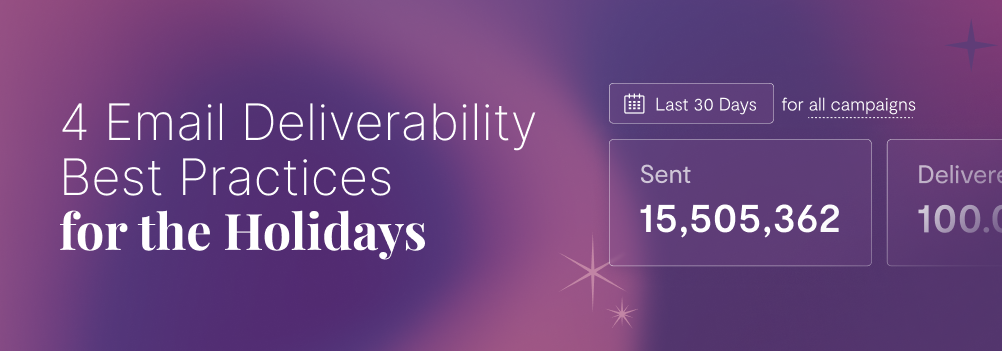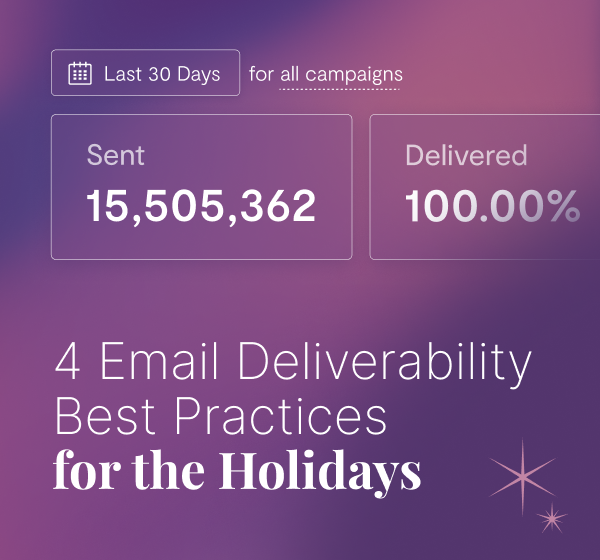

4 Email Deliverability Best Practices for the Holidays
Retailers can make up to 40% of their annual sales during the holidays. Naturally, this means they tend to up their send volume, which can unfortunately lead to email deliverability issues.
Last year, Bluecore customers sent about 40% more emails during November and December relative to the rest of the year. Strong deliverability best practices ensured those messages didn’t bounce and actually made it to their customers’ inboxes.
Deliverability is the unsung hero of email marketing. According to Email Tooltester, the average email deliverability rate is 83.1%. Most senders rely on the “delivered rate” to judge their email deliverability. If your emails end up in the spam folder, as 10.5% do, they are lost in the digital abyss and go unnoticed by your subscribers.
These four deliverability best practices will help you stay on top of your email game — and out of the spam folder — this holiday season. If you’re a Bluecore customer and need additional guidance, please contact your CSM for additional information or guidance.
Conduct an email marketing program audit
It doesn’t matter how beautiful your email creatives are or how many email campaigns you plan to add for the holiday season if your emails land in spam. Before the holidays ramp up, set yourself up for success with an extensive audit to test your email deliverability.
Start by reviewing your authentication and ensuring your records are in place for:
- Sender Policy Framework (SPF), identifying whether a sending server has permission to send mail from a particular domain
- DomainKeys Identified Mail (DKIM), a digital authentication that ensures the sender has permission to use the domain and that message wasn’t tampered with
- Domain-Based Message Authentication, Reporting and Conformance (DMARC), which allows senders to see how their domains are being used to send email
If you are a Bluecore customer, your authentication (SPF and DKIM) should be in place. However, DMARC is out of our hands.
Gmail now requires that senders publish a DMARC policy for their sending domain to protect against spoofing and phishing. We recommend you work with your DMARC vendor to update that record.
Increase email marketing send volume gradually
While you’ll likely send more emails during the holiday season, it’s important not to do too much, too soon. A sudden spike in volume is a major red flag for ISPs, which can damage your email deliverability success rate.
Instead, build an operational rhythm by ramping up slowly.
To minimize risk, avoid daily volume spikes greater than 30%. This will help you maintain a strong sender reputation and avoid soft bounces (what happens when an ISP blocks your email due to reputation issues).
Keep your email lists clean
ISPs can review thousands of signals when determining your sender reputation. However, list quality is a consistent factor in successful email deliverability across the board.
Don’t send to your inactive lists without first vetting if their email addresses are valid or not. While soft bounces usually happen because of something temporary, hard bounces happen when you message a nonexistent or invalid email address.
Remember, testing and auditing will help improve your email deliverability.
Hard bounces factor into sender reputation so be sure to remove any invalid users to keep your lists clean prior to any holiday sends. Note that it can take more than a week to cleanse a list.
Reactivate and re-engage
People’s shopping habits are atypical during the holidays, when they’re purchasing from different brands and categories in search of that perfect gift. Re-engaging lapsed subscribers during this time is a great tactic, but doing so with deliverability in mind is a must.
Like increasing send volume, re-engagement is a marathon, not a sprint. Space a handful of campaigns over time, asking subscribers to take specific actions based on their open and click activity.
Focus on those who have received — but not engaged with — your emails in the last six months. Targeting those who haven’t received emails during this period can be risky so be sure to consult with your account team first.





